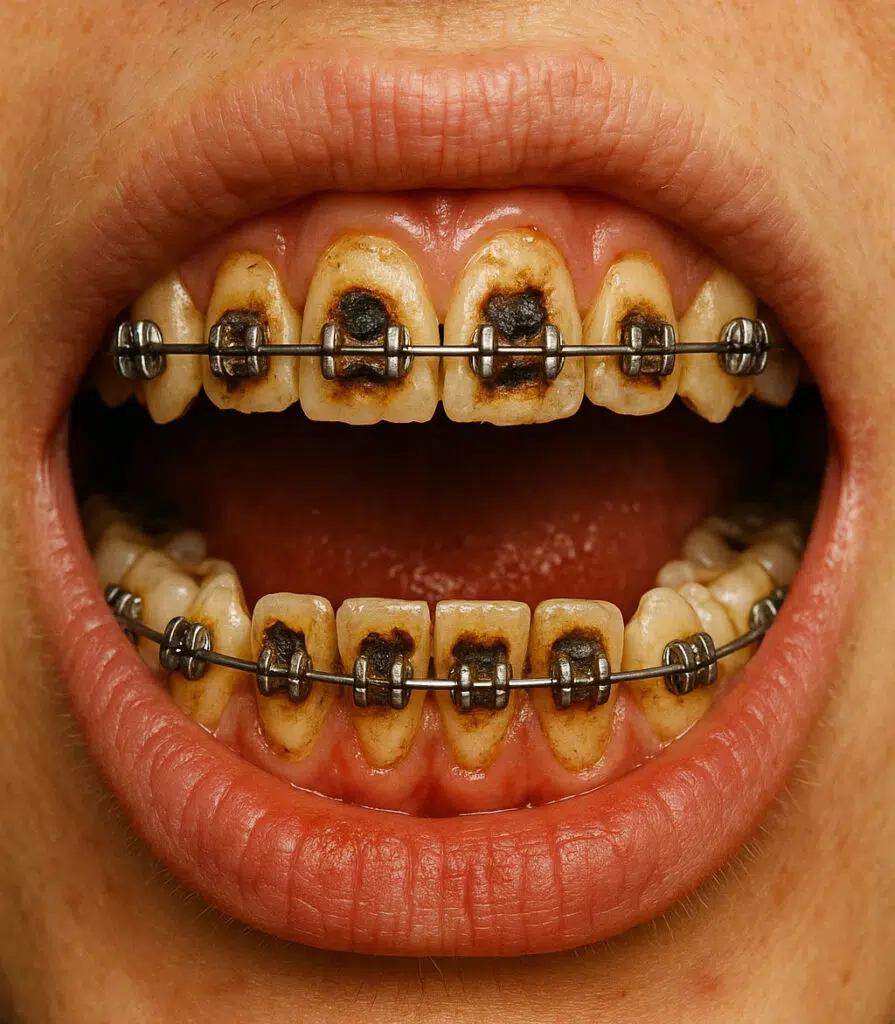Side Effects of Wearing Braces Too Long
The Hidden Risks of Extended Orthodontic Treatment: When Braces Overstay Their Welcome

The side effects of wearing braces too long are not good. While orthodontic braces have transformed millions of smiles, they’re designed to work within specific timeframes.
Most orthodontic treatments last 18 to 36 months. Unfortunately, patient’s sometimes leave braces on against Dr. Dallam’s advice. This can happen for a variety of reasons and can lead to extended wear periods that may pose serious risks to oral health.
Understanding Normal Treatment Duration
Typical orthodontic treatment follows a carefully planned timeline based on the complexity of tooth movement required. Simple cases might resolve in 12-18 months, while complex realignments can take up to three years. Orthodontists monitor progress through regular appointments, making adjustments and tracking movement toward the desired outcome.
When Treatment Extends Beyond Plan
Several factors can cause treatment to run longer than expected. Poor patient compliance with oral hygiene, missed appointments, or failure to wear rubber bands as prescribed can significantly delay progress. Sometimes, patient’s do not have the ability to finsih paying for their treatment and avoid seeing the orthodontist. This is a terrible decision. A doctor first responsibility is the health of the patient. At Augusta Orthodontics we remind patients payment can be made later and has nothing to do with your finishing your treatment.
More concerning are situations where patients lose contact with their orthodontist, move without transferring care, or continue wearing braces without professional supervision due to financial constraints or other barriers to care.
One of the strangest reason we find is patients leaving braces on because they like the way they look!
Oral Health Complications
Extending your braces wear creates a perfect storm for oral health problems. The brackets and wires create numerous spaces where food particles and bacteria accumulate, making thorough cleaning challenging even with proper technique. Over months or even years of extended wear, this can lead to several serious conditions.
Dental decay becomes increasingly likely as plaque builds up around brackets. The acidic environment created by bacteria can cause permanent white spot lesions on tooth enamel or progress to cavities requiring fillings. These cosmetic and structural damages often persist long after brace removal.
Gum disease represents another significant risk as the soft gum tissue becomes inflammed and starts overlapping the brackets and wires. This chronic inflammation from bacterial buildup can progress from reversible gingivitis to periodontitis, potentially causing permanent gum recession and bone loss around teeth. The tissues may become so inflamed that they grow over parts of the braces, creating additional cleaning challenges.
Dr. Dallam wants everyone of his patients to know:
Keeping your braces on longer than recommended is not safe and presents a great risk to the health of your teeth and mouth.
Root Resorption: The Silent Threat
One of the most serious risks of prolonged orthodontic force is root resorption, where the roots of teeth gradually shorten as the body reabsorbs the root structure. While minor resorption occurs in most orthodontic cases, over-extending treatment significantly increases this risk.
Root resorption typically occurs without symptoms, making regular X-rays during treatment essential for early detection. Severely shortened roots can compromise tooth stability and longevity, potentially requiring complex treatments or even tooth extraction and replacement later in life.
Mechanical and Structural Problems
Braces and their components were not designed for indefinite wear. Extended use can lead to metal fatigue, bracket failure, and wire breakage. Loose or broken components can cause soft tissue injuries, create sharp edges that damage cheeks and tongue, or allow uncontrolled tooth movement.
The adhesive used to bond brackets to teeth can also deteriorate over time, leading to bracket failure or, conversely, making removal more difficult and potentially damaging to tooth enamel.
Psychological and Social Impact
The side effects of wearing braces too long can be a strain on your mental health.
Beyond physical complications, extended orthodontic treatment can take a psychological toll. Patients may experience frustration, embarrassment, or loss of confidence, particularly adults who expected treatment to conclude within a reasonable timeframe.
The prolonged dietary restrictions and oral hygiene challenges can significantly impact quality of life.
Prevention and Solutions
The key to avoiding these complications lies in maintaining regular orthodontic care throughout treatment and attending your scheduled appointments.
Patients should prioritize scheduled appointments, follow all instructions regarding oral hygiene and appliance care, and communicate promptly with their orthodontist about any concerns or changes in circumstances.
Financial constraints should not threaten to interrupt your care. Many orthodontists, including Dr. Dallam, offer payment plans that are completed before ortho treatment is started. Once you are financially approved and treatment begins, not being able to make your payments has nothing to do with completing your treatment.

It is the orthodontists responsible to complete your care regardless of payment. However, not making the payments will affect your credit score.
We do not refer patients to dental schools or community health centers for continued treatment if payment can not be made. Referrals to other orthodontic treatment centers will only be done if patients move away and cannot complete care at Augusta Orthodontics.
The cost of maintaining proper orthodontic care is invariably less than treating the complications that arise from abandoned treatment. Replacing teeth with implants and crowns can cost thousands of dollars. The last thing we want to remove teeth after removing your braces.
For patients who have lost contact with their orthodontist or are experiencing extended treatment, seeking evaluation from another qualified orthodontist is crucial. Augusta Orthodontics offers free referral service to the orthodontist of your choosing.
Even if starting over with a new provider, professional assessment can determine the best path forward and prevent further complications.
The Bottom Line
While orthodontic treatment requires patience, braces are not meant to be permanent fixtures. The side effects of wearing braces too long are not good. Extended wear beyond appropriate recommended treatment duration poses real risks to both oral health and overall well-being.
Patients that are experiencing prolonged treatment should seek professional evaluation to ensure their orthodontic journey concludes successfully without compromising their long-term dental health.
Regular communication with orthodontic providers, diligent oral hygiene, and adherence to treatment protocols remain the best strategies for achieving a beautiful, healthy smile within the intended timeframe.